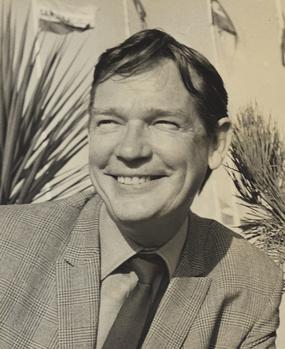Walter Keane facts for kids
Quick facts for kids
Walter Keane
|
|
|---|---|
 |
|
| Born |
Walter Stanley Keane
October 7, 1915 Lincoln, Nebraska, U.S.
|
| Died | December 27, 2000 (aged 85) Encinitas, California, U.S.
|
| Known for | Plagiarism |
| Spouse(s) |
Barbara Ingham
(div. 1952)Joan Mervin |
Walter Stanley Keane (October 7, 1915 – December 27, 2000) was an American man who became famous in the 1960s. He claimed to be the painter of popular artworks showing sad-looking people with very large eyes. However, these paintings were actually created by his wife, Margaret Keane.
When Margaret finally shared her side of the story, Walter tried to fight back. He published an article in USA Today saying he was still the artist. In 1986, Margaret sued Walter and USA Today. During the court case, the judge asked both Walter and Margaret to paint a picture right there. Walter said his shoulder hurt and refused. Margaret, however, painted a complete picture for the jury in just 53 minutes. The jury decided she was right and awarded her $4 million in damages.
Contents
Walter Keane's Life Story
Walter Keane was born in Lincoln, Nebraska, on October 7, 1915. He was one of ten children from his father's second marriage. His mother, Alma Christina Keane, was from Denmark, and his father, William Robert Keane, was of Irish background.
Walter grew up in Lincoln and earned money by selling shoes. In the early 1930s, he moved to Los Angeles, California. There, he went to Los Angeles City College. In the 1940s, he moved to Berkeley, California, with his first wife, Barbara Ingham. They both worked as real estate brokers.
Their first child, a son, sadly died soon after birth. In 1947, they had a healthy baby girl named Susan Hale Keane.
In 1948, Walter and Barbara bought a large house in Berkeley. They then traveled to Europe, living in Heidelberg and Paris. When they returned home, they started a toy business called "Susie Keane's Puppeteens." They taught children French using handmade puppets, records, and a book. Their home's ballroom became a workshop where they made and painted wooden puppets. These puppets were sold in fancy stores.
Barbara Keane later became a leader in dress design at the University of California, Berkeley. Walter then closed his real estate business and the toy company to focus on his painting. His marriage to Barbara ended in divorce in 1952.
Meeting Margaret and the Big Eyes Art
In 1953, Walter met an artist named Margaret Doris Hawkins Ulbrich at a fair. She was making charcoal sketches. They got married in 1955.
During their marriage, and even after they separated, Walter sold Margaret's unique "big eyes" paintings as if they were his own. By doing this, he earned millions of dollars over many years. The movie Big Eyes tells this story in great detail.
Walter married his third wife, Joan Mervin, after divorcing Margaret in 1965. They had two children in the early 1970s while living in London. This marriage also ended in divorce.
Walter Keane passed away on December 27, 2000, in Encinitas, California. He was 85 years old.
The Famous Big Eyes Paintings
Walter first showed Margaret's paintings as his own in 1957. This was at an outdoor art show in Washington Square Park in New York City. The paintings quickly became very popular.
In 1961, a company bought one of the paintings called "Our Children." They gave it to the United Nations Children's Fund. This painting is now part of the United Nations' permanent art collection. By 1965, Walter Keane was called "one of the most controversial and most successful painters today." Many famous people owned artworks that were said to be by him.
LIFE magazine interviewed Walter Keane in 1965. He claimed that his idea for the big-eyed children came from seeing innocent children in Europe after World War II. He said, "In their eyes lurk all of mankind's questions and answers." He wanted his paintings to make people feel strongly and want to help. In the same interview, he proudly said, "Nobody could paint eyes like El Greco, and nobody can paint eyes like Walter Keane."
The Truth About the Artist
In 1970, Margaret Keane announced on a radio show that she was the true artist of the paintings. Walter and Margaret continued to argue about who painted them. When Walter suggested Margaret only claimed to be the painter because she thought he was dead, she sued him in federal court for making false statements.
During the court hearing, the judge asked both Margaret and Walter to paint a big-eyed child picture in the courtroom. Walter refused, saying his shoulder hurt. Margaret, however, finished her painting in just 53 minutes. After three weeks of trial, the jury decided that Margaret was the real artist. They awarded her $4 million in damages. Later, a court of appeals agreed with the decision that Walter had made false statements.
Walter Keane in Movies
Tim Burton directed and produced the 2014 film Big Eyes. This movie is based on Margaret Keane's life story. It was released in theaters in December 2014. Christoph Waltz played Walter Keane, and Amy Adams played Margaret. Amy Adams even won a Golden Globe Award for her amazing acting in the film.
See also
 In Spanish: Walter Keane para niños
In Spanish: Walter Keane para niños

